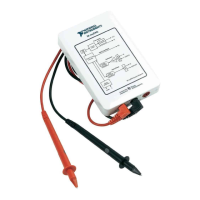NI myDAQ User Guide | © National Instruments | 11
The difference in ground potential between two instruments connected to the same building power
system is typically between 1 and 100 mV. This difference can be much higher if power
distribution circuits are improperly connected. If a grounded signal source is improperly measured,
this difference might appear as a measurement error. Connect the differential analog inputs across
the signal source and do not connect the NI myDAQ AGND pin to the grounded source.
Figure 6. Ground-Referenced Differential Connection
Floating Signal Sources
A floating signal source is not connected to the same ground reference as NI myDAQ, but
instead has an isolated reference point. Some examples of floating signal sources are
battery-powered devices, outputs of transformers, thermocouples, optical isolator outputs, and
isolation amplifiers. An instrument or device that has an isolated output is a floating signal
source. You must connect the ground reference of a floating signal to an NI myDAQ AGND pin
through a bias resistor or jumper wire to establish a local or onboard reference for the signal.
Otherwise, the measured input signal varies as the source floats out of the common-mode input
range.
The easiest way to reference the source to AGND is to connect the positive side of the signal to
AI+ and connect the negative side of the signal to AGND as well as to AI- without using
resistors. This connection works well for DC-coupled sources with low source impedance (less
than 100 Ω).
Figure 7. Differential Connections for Floating Signal Sources without Resistors
For larger source impedances, however, this connection leaves the differential signal path
significantly off balance. Noise that couples electrostatically onto the positive line does not
couple onto the negative line because it is connected to ground. This noise appears as a
differential-mode signal instead of a common-mode signal, and thus appears in your data. In this
case, instead of directly connecting the negative line to AGND, connect the negative line to
AGND through a resistor that is about 100 times the equivalent source impedance. The resistor
puts the signal path nearly in balance, so that about the same amount of noise couples onto both
+
–
+
–
AI+
AGND
Signal Source
AI–
+
–
AI+
AGND
Signal Source
R
source
>100
Ω
AI–
+
–

